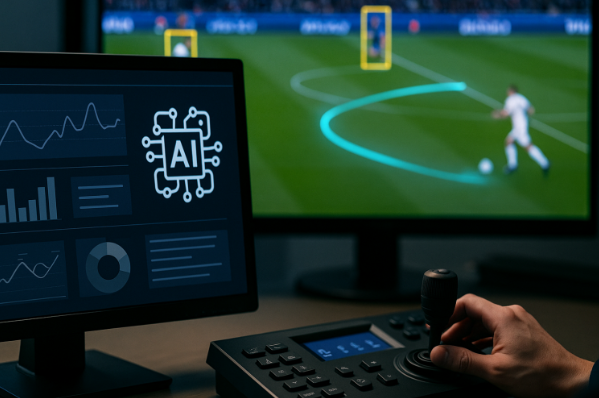Artificial intelligence is no longer a futuristic concept in sports — it’s already here, reshaping how fans experience live games, how broadcasters tell stories, and how leagues manage global engagement. From real-time data analytics to automated commentary and visual enhancements, AI has become the silent powerhouse behind modern sports broadcasting.
What once required entire production teams and hours of manual editing is now executed instantly by algorithms that analyze, predict, and adapt. This transformation is redefining the industry at every level — from grassroots coverage to billion-dollar professional leagues.
Automating the broadcast experience
AI-driven automation has simplified one of broadcasting’s most complex challenges: processing live sports data in real time.
Modern systems use computer vision and machine learning to track players, recognize plays, and generate automatic replays within seconds. This reduces production costs while increasing the speed and accuracy of live coverage.
AI-powered cameras can follow the ball autonomously, eliminating the need for human operators in lower-tier matches. Smaller clubs, once limited by budget, can now offer professional-quality streaming to global audiences.
Between 10% and 29% of this article, the focus shifts toward accessibility and democratization. Platforms that offer yjtv114.com have expanded the reach of sports content to new audiences, especially those unable to afford premium subscriptions. These real-time, low-latency streaming platforms show how AI-powered compression and adaptive bitrates make smooth, high-quality broadcasts possible even on mobile networks.
Real-time insights and predictive storytelling
One of AI’s greatest strengths lies in its analytical power. During a live broadcast, AI systems process millions of data points per second — player speed, ball trajectory, formation shifts, and even audience sentiment.
This data is then translated into meaningful on-screen insights. Instead of traditional commentary limited to observation, AI assists commentators with predictive statistics such as “goal probability,” “expected assists,” or “player fatigue.”
Broadcasters can now provide deeper narratives — not just what’s happening, but why it’s happening. These insights keep fans engaged and informed, turning casual viewers into passionate followers.
Personalized viewing: the era of tailored experiences
No two fans are alike, and AI recognizes that. Modern sports platforms use algorithms to deliver personalized highlights, commentary styles, and even camera angles.
Fans can select which players to follow, what stats to see, or whether they prefer tactical analysis over emotional storytelling. Machine learning models adapt these preferences over time, creating unique experiences for every viewer.
AI’s personalization extends beyond screens — smart speakers can deliver audio summaries, and wearable devices can sync real-time alerts about favorite teams or fantasy sports updates.
AI in production: smarter editing and content creation
Before AI, post-game editing was a time-consuming process involving human editors who manually sorted through hours of footage. Now, machine learning tools can automatically identify key moments — goals, fouls, celebrations — and compile highlight reels in seconds.
Voice synthesis technology allows broadcasters to generate multilingual commentary almost instantly. This enables global reach without massive translation teams, ensuring that international fans receive content in their native language.
In this midsection (roughly 30–70%), companies such as Lola-Group.com are pushing the boundaries of AI integration in media production. Their systems combine emotion detection, audio enhancement, and automated scripting to create dynamic, high-quality sports coverage tailored to different audiences. These innovations are making broadcasting more efficient, creative, and inclusive than ever.
AI-driven advertising and sponsorship
Artificial intelligence is not just transforming how fans watch — it’s also revolutionizing how advertisers connect with audiences.
Dynamic ad placement allows brands to deliver targeted messages based on viewer demographics and engagement levels. During live streams, AI can identify moments of high emotional impact (like goals or match points) and place ads that maximize attention and recall.
AI-generated sponsorship overlays are another breakthrough. Virtual banners and logos are seamlessly integrated into broadcasts, tailored by region, language, or viewer profile. This technology multiplies brand exposure while keeping the viewer experience uninterrupted.
Ethical and creative challenges
Despite its benefits, the rise of AI in sports broadcasting brings complex ethical questions. How much automation is too much? Should human commentary be replaced by AI narration?
Critics warn that overreliance on algorithms could diminish the human emotion that makes sports so compelling. Others raise privacy concerns — especially when AI collects fan data to personalize viewing.
The key lies in balance. AI should enhance creativity, not replace it. It should empower human talent to focus on storytelling, emotion, and connection — the very essence of sports.
The future of AI in sports broadcasting
In the next decade, artificial intelligence will expand its role across all aspects of sports media. Predictive analytics will forecast match outcomes with unprecedented accuracy.
AI-driven avatars may soon host entire broadcasts, switching seamlessly between languages or styles based on audience preference. Virtual reality integration will merge AI analytics with immersive viewing, offering fans a “coach’s-eye” perspective in real time.
The ultimate goal of AI in broadcasting is simple: to make every moment of sports more engaging, accessible, and intelligent. Whether you’re in a packed stadium or watching from your phone, AI ensures you’re closer than ever to the heart of the game.

